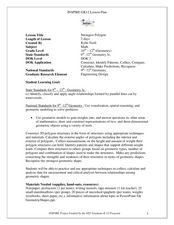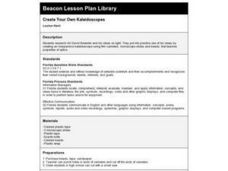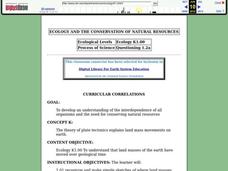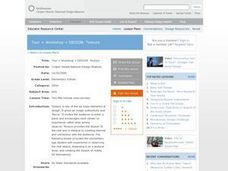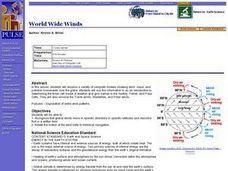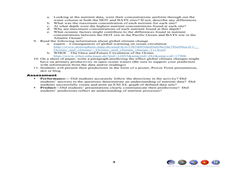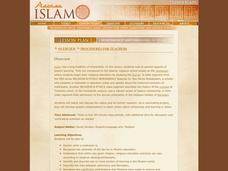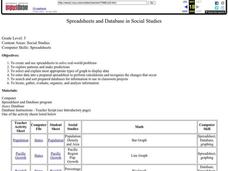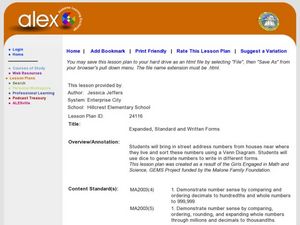Curated OER
Animal Babies on the Farm
Students identify different farm animals and match farm animal babies to their parent(s). They recognize more specific gender terminology for farm animals.
Curated OER
Telling Time to 5 Minutes
Students take part in various activities ranging from creating a human clock, to small group problem solving to reinforce the concept of telling time accurately to five minutes on an analog clock.
Curated OER
Strongest Polygon
Students define and identify shapes by name. In this geometry lesson, students construct, identify and compare polygons based on the number of sides. They classify each shape based on their angle sum theorem.
Curated OER
Create Your Own Kaleidoscopes
Seventh graders create a kaleidoscopes after researching Sir David Brewster and his ideas on light. They recognize the properties of optics from making and using the kaleidoscopes.
Curated OER
Ecology And the Conservation of Natural Resources
Students study Alfred Wegener's theory of continental drift and how the continents were connected in one large land mass called Pangaea. They examine plate tectonics and the theory that the earth's surface is composed of large moving...
Curated OER
Famous People Research Project
Fourth graders research a famous person in Michigan history. They will use at least three different resources including technology to conduct their research. They then will use various forms of technology to create individual research...
Curated OER
Composing Project
Students design, compose, and present short musical compositions for keyboard in this lesson plan meant for the high school choir class. This lesson can be adapted to any time frame, but the author suggests a considerable amount of time...
Curated OER
Changing Places
This lesson involves live ladybugs. Students view two containers of water and take the temperature of each. They construct a graph on chart paper to compare the two containers. Students speculate which water sample the ladybugs will like...
Curated OER
Design and Texture
Students experience how texture is one of the six basic elements of design. It gives an image authenticity and 'flavor'. It invites the audience to enter a piece and encourages each viewer to experience rather than simply observe.
Curated OER
World Wide Winds
Pupils recognize that global winds move in specific directions in specific latitudes and describe that in a written form. They relate the motion of the wind belts to historical navigation.
Curated OER
Tribal Diversity within the Indigenous Peoples of the North American Continent
Pupils, after brainstorming what they already know about Indians, explore and analyze the tribal diversity within the Indigenous Peoples of North America. They recognize that American Indians have their own unique language origins,...
Curated OER
Bats and Hot Dogs
Students identify patterns and relationships from data that is collected and solve variables. In this investigative lesson students study ocean productivity, the nitrogen cycle and phytoplankton then answer questions.
Curated OER
Scholarship and Learning in Islam
Young scholars explain what a madrasah represents in Islam. Using the Muslim world as an example, they identify and describe two or more centers of learning. They explain the contributions that Muslims have made to science and math and...
Curated OER
Narratives in the Simple Past
Students recognize the simple past forms in a folktale. They supply some of these forms when asked
Curated OER
Family Stories and Personal Narratives
Fourth graders read various stories in their literature books about families. Individually, they make a timeline showing the most important events in their lives. They bring in one artifact from their lives and write a paper about it...
Curated OER
Spreadsheets and Database in Social Studies
Fifth graders create/use spreadsheets to solve real-world problems, explore patterns and make predictions, select/explain most appropriate types of graph to display data, and enter data into a prepared spreadsheet to perform calculations.
Curated OER
Introduction to Adverbs
Students categorize a list of words into various categories of their choosing. They notice patterns in the lists and discuss -ly words and adverbs. They practice adding adverbs to sentences.
Curated OER
Grammar Lesson Plan
Students in an adult ESL class practice everyday english patterns. They identify how to use "want to", "need to" and "have to". They practice as a whole class and review concepts as necessary.
Curated OER
Forms of Poetry
Students identify distinguishing features of poetry. They identify and use literary terminology including symbol, theme, simile, and alliteration. They recognize the effects of language.
Curated OER
"Weather" or Not?
Students complete a three week unit about weather and how it affects our behavior. They read and discuss various books related to weather, conduct an experiment about the tilt of the earth, plan a field trip based on temperature,...
Orange County Department of Education
Pepita Talks Twice
Third graders read Pepita Talks Twice and define the character traits of respect and responsibility. They write their examples of the characters traits on a character trait doll. Students recognize the character traits of respect and...
Curated OER
Expanded, Standard and Written Forms
Students explore expanded, standard, and written forms of numbers. In this number sense lesson, students examine the various ways of writing numbers as they complete a Venn diagram activity.
Curated OER
What are Rocks and Minerals? How can they help us?
Sixth graders investigate the difference between rocks and minerals. They name the three kinds of rocks (sedimentary, igneous, and metamorphic) and know the differences between them.
Curated OER
It's Waltz Time!
Pupils, after hearing and viewing a video of the waltz scene from the musical, "Cinderella," by Mary Rodgers, "physicalize" a three beat rhythm with accompaniment video and discuss and evaluate triple meter. They master a song in 3/4...


